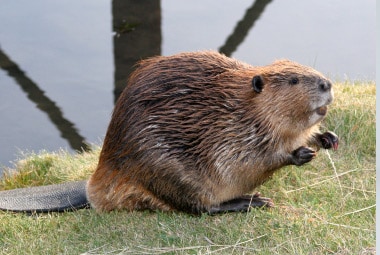
The North American Beaver, aka ‘Beaver’, is the largest rodent in North America. This mammal is notorious for its cute and fuzzy face, with two large incisors protruding out from its top jaw. They range anywhere from 24 to 71 pounds and the head and body length is 29 to 35 inches. Their famous tail adds an additional 8 to 14 inches!
| Pest Identification | |
|---|---|
| Recognition | Beavers are dark brown in color. They have four legs. Their front legs are small front and have clawed paws, and their back legs are larger with big webbed feet. They have a very obvious paddle tail which is flat and scaly. They use this tail to not only help them propel through water, but also to slap on the surface of the water as a signal that danger is nearby and to possibly scare away any predators. This tail also is a place where the beaver stores fat. These semi-aquatic creatures are extremely adept at living in and out of water, even if its cold water. They have a double coat of fur. The under fur is short and fine and serves as an insulator while their outside layer of fur is long and coarse. Using a secretion from a gland near their genitals called casoreum, they rub this on their outer fur layer and are all but water proof. Their double fur and a thick layer of fat under their skin help them to be insulated against cold and icy water temperatures. Beaver’s two front teeth (incisors) grow continuously from their upper jaw. They have to constantly chew wood to keep them at a reasonable length. |
| Biology | Beavers mate for life. A pair will meet up and live their lives together in their territory raising multiple litters together. Breeding season is in the winter months of January –February. Gestation period lasts for about four months. The average litter is 4 ‘kits’. They are born with all their fur and learn to swim shortly after birth. The kits don’t leave the den, the parents supply food for them. Beavers usually store food in tunnels in and around their den. If the young kits are outside the den for too long they could become victims to predators such as: Eagles, Owls, Coyotes, Lynx, Wolves, and Mountain Lions. These kits will stay with their parents until they are two years old. Then they will head off to start their own family and to claim their own territory. Beavers live in a family colony. Often they have a new litter of kits from the present year and last year’s kits will still be there too. No matter the age of the kits that are still staying with their parents, the only ones that reproduce are Mom and Dad. The life span of a beaver can range anywhere from 16 to 24 years. |
| Habits | Beavers can be found all over the North American continent. They are constantly building and repairing their ‘lodges’ that they build out of sticks, twigs, rocks and mud in lakes and streams. These lodges can be surrounded by water or partially on land. These are their dens that they live in. They are also notorious for building dams across streams and constructing their lodge in the artificial pond that forms because of their dam. Contrary to popular belief, they don’t eat fish. Their primary diet is from the leaves, inner tree bark, shoots and buds. They prefer aspen, red oak, black cherry, ash, beech, hornbeam and occasionally spruce and pine. They do also eat some cattails, aquatic vegetation and water lilies, especially in the early spring. |
| Prevention | Beavers try to avoid contact with us, however, they can sometimes get into our streams and ponds. There are a number of DIY products available to use, but these can be costly, dangerous and unsuccessful. There are trapping systems and pond leveler systems available to try. You can try to modify their habitat on a daily basis by destroying the dam and removing the construction materials. You will have to do this over and over again, and you may be able to eventually discourage them from building on that particular site. |
| Professional | Professional wildlife specialists use a variety of methods to stop beavers. These are the major ways that professionals remove or stop beavers: Lethal-trapping, Snares, Live trapping & relocation, Habitat modification and harassment. Beavers are wildlife and can be dangerous, therefore they should always be handled by a wildlife expert. |

